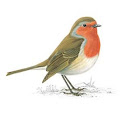Do you ever find yourself wishing you were an artist? And by artist, I mean visual artist. I often wish I could pick up a pen, or a paintbrush, or a printer's block, and create beautiful, colorful images. I am so inspired by the webpage Etsy, which is an incredible marketplace for people to sell unique, handmade goods and artworks. I especially love some of the rustic woodblock prints and collages that I see there. I know I could just dive in and start making art, but I need to accumulate supplies, and besides, most of the time words suffice as my paintbrush. At least, they are more portable.
This also makes me think about the interaction of the visual arts and poetry. Last year, I taught a community center class on Poetry and Music, which was really fruitful for all of us, and personally productive. I found such a wealth of poetry on the subject of music, not to mention poetry that is itself inherently musical or written in musical forms (this last idea, in particular, is something I would like to pursue in my poems).
Poetry and the visual arts also has a long tradition. The technical term for a written description of a visual image is ekphrasis, from the Greek, meaning "speaking out" (ek=out, phrasis=speak); it's as if by re-drawing the image in words you are sending forth its inner essence. Or perhaps the other way around. In the best poetic examples of ekphrasis, I think, the poem is not a mere "description" of the poem, but considers it, reworks it, adds to it, is inspired by it.**
An example of ekphrasis that I love is Auden's poem on Breughel's painting of Icarus falling from the sky, called "Musée des Beaux Arts." The title alone makes it about more than just the one painting; and indeed, Auden begins with an invocation of all the "Old Masters" and their view of suffering as a small corner of life's dailiness. He only turns toward the Breughel painting at the end:
About suffering they were never wrong,
The Old Masters; how well, they understood
Its human position; how it takes place
While someone else is eating or opening a window or just walking dully along;
How, when the aged are reverently, passionately waiting
For the miraculous birth, there always must be
Children who did not specially want it to happen, skating
On a pond at the edge of the wood:
They never forgot
That even the dreadful martyrdom must run its course
Anyhow in a corner, some untidy spot
Where the dogs go on with their doggy life and the torturer's horse
Scratches its innocent behind on a tree.
In Breughel's Icarus, for instance: how everything turns away
Quite leisurely from the disaster; the ploughman may
Have heard the splash, the forsaken cry,
But for him it was not an important failure; the sun shone
As it had to on the white legs disappearing into the green
Water; and the expensive delicate ship that must have seen
Something amazing, a boy falling out of the sky,
had somewhere to get to and sailed calmly on.
I'm undecided as to whether it is important to include the painting alongside the poem. Shouldn't the poem do the work of invoking the image? But at the same time, they interact in a nice counterpoint. I remember so clearly where I encountered them first, in a lovely poetry textbook called Western Wind. Would my view of the poem be different if I had never seen the painting? The original is, by the way, here in Brussels! The Beaux-Arts museum referred to in the title is right around the corner. I will have to go see it.
By the way, there is a William Carlos Williams poem on the same painting, and although in tone and form it is quite different from the Auden, the point is much the same. It would make a nice classroom exercise to consider the two poems together and identify what makes them different, naming the techniques.
Someday, I would love to write a book of poems and include my own artwork, or someone else's, and see how the visual and the verbal interact. This is, of course, not a new idea, but one I would like to try for myself. I would like to see that interaction go beyond "mere" description, into the non-representative territory—a territory already inhabited by music.
**Note to students googling the web for some paper ideas—or worse, some quotes to copy and paste and then pass off as your own—regarding the Auden poem or ekphrasis in general: forget about it. Your teacher will be able to tell that this was written by someone who is Not You, I promise. If you must copy and paste, do so honestly, and quote me following correct MLA style. Here, I’ll even give you an example. It's a little tricky since I never publish my last name on the site; normally, you would include the author's lastname/firstname, as the generic formula below indicates. Also, normally the URL would be between angle brackets, but it disappears if I do that...:
"Exegesis in blue and green." [Weblog entry.] Cant d'Ocell. 9 March 2007. (http://cantdocell.blogspot.com/2007/03/exegesis-in-blue-and-green.html). 1 January 2009.
Lastname, Firstname. "Title of individual blog entry." [Weblog entry.] Name of Weblog. Sponsoring organization (if any; such as a university, a publication, or a company). Date posted. (URL to permalink). Date accessed.
09 March 2007
Exegesis in blue and green
Subscribe to:
Post Comments (Atom)

No comments:
Post a Comment